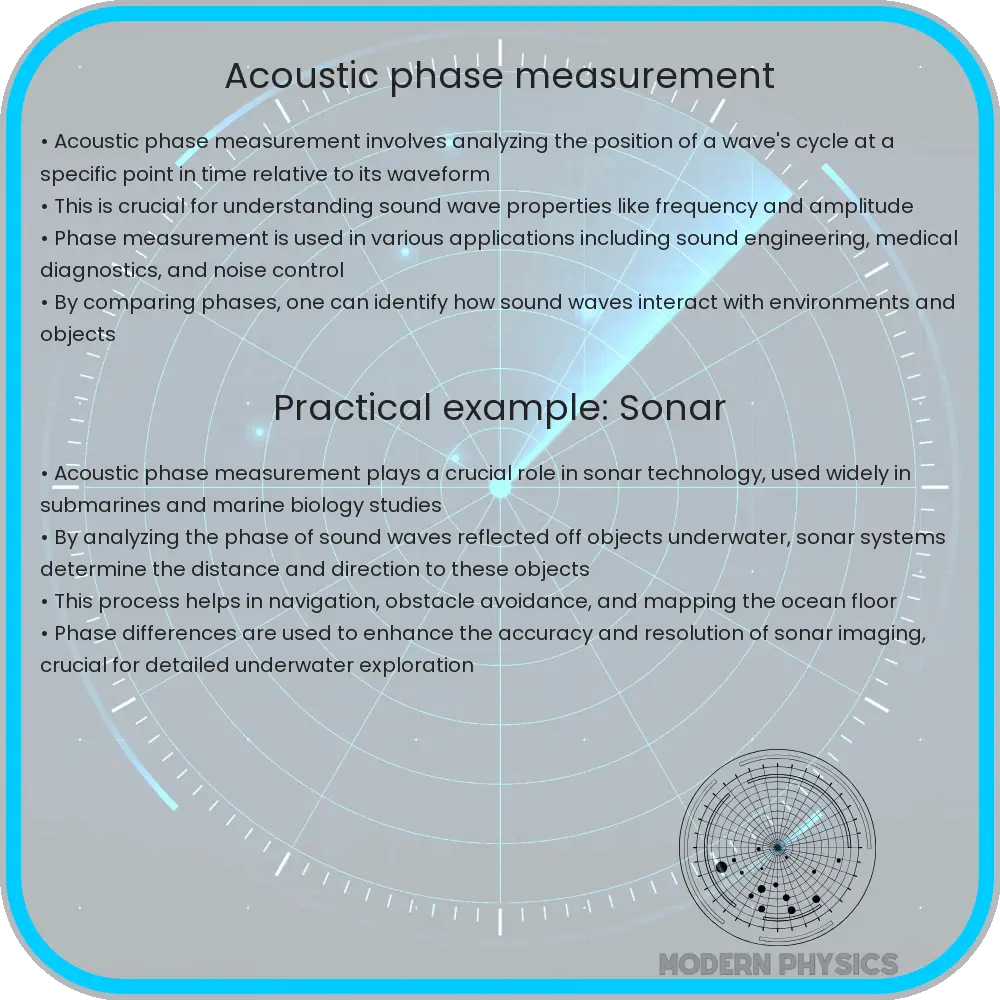Explore the critical role and techniques of acoustic phase measurement in enhancing audio quality, architectural acoustics, and oceanography.

Understanding Acoustic Phase Measurement
Acoustic phase measurement plays a crucial role in various fields of engineering and physics, including audio technology, architectural acoustics, and even in oceanographic studies. By understanding the phase relationships between different sound waves, professionals can enhance sound quality, improve architectural designs for better sound distribution, and even map underwater surfaces more accurately.
Precision in Acoustic Phase Measurement
The precision of acoustic phase measurements is pivotal, as slight errors can lead to significant discrepancies in data interpretations. Acoustic phases are measured in degrees (°) and typically involve calculations of the time difference a sound wave takes to travel from one point to another. The precision often hinges on the equipment used, such as high-quality microphones and precise timing devices. The environment in which measurements are taken also significantly affects accuracy; factors like background noise, air temperature, and humidity must be controlled or accounted for.
Techniques in Acoustic Phase Measurement
- Interferometry: This technique involves the superposition of two or more sound waves to study the resulting interference pattern. By examining these patterns, the phase differences can be deduced accurately.
- Time-Difference-of-Arrival (TDOA): Often used in architectural acoustics, TDOA measures the time difference as a sound wave arrives at different microphones at known distances. This time difference helps in calculating the phase difference between the waves.
- Dual-Microphone Method: This method uses two microphones placed a known distance apart. The phase difference is measured based on the sound waves received by these microphones. This technique is particularly useful in noisy environments.
Analysis Techniques for Acoustic Phase Data
Once the phase data is collected, analyzing it correctly is essential for accurate interpretations. Analysis often involves comparing measured phase data against theoretical models or simulations.
- Fourier Transform: This mathematical transform converts time or space to frequency or wave number domains, respectively. It is particularly useful for analyzing periodic signals.
- Phase Unwrapping: Sound waves can have phase shifts greater than 360°. Phase unwrapping is the process of adding or subtracting multiples of 360° to the phase data to return the correct phase measurement values.
- Cross-Correlation: Cross-correlation techniques compare the phase of a measured signal with a reference to determine similarities and differences. This method is extensively used in error analysis.
Acoustic phase measurement is not just about collecting data but ensuring that each part of the process from data collection, through to analysis, is done with the highest level of precision and accuracy. Advanced techniques and careful consideration of environmental factors play a key role in achieving reliable results.
Applications of Acoustic Phase Measurement
Acoustic phase measurement is not only important for theoretical studies; its practical applications are vast and impactful across different industries:
- Audio Engineering: In the world of music and audio production, understanding and manipulating phase relationships helps in creating clear and balanced sound outputs. It is essential for sound mixing and ensuring sound quality in concerts and recordings.
- Medical Imaging: Techniques such as ultrasound imaging rely on acoustic phase measurements to create detailed images of internal organs. This assists doctors in diagnostics and treatment planning.
- Maritime Navigation: The technology is also used in sonar systems for underwater navigation and exploring ocean floors, where precise phase measurements can detect objects, measure distances, and map topography.
- Architectural Design: Architects use acoustic phase data to design buildings with better sound environments, essential in concert halls and theatres where sound clarity and distribution are paramount.
Future Trends in Acoustic Phase Measurement
As technology advances, the methods and applications of acoustic phase measurement continue to evolve. Future trends may include the integration of AI and machine learning to automate and enhance phase analysis, leading to faster and even more accurate results. Additionally, improvements in sensor technology and digital processing tools will allow for more detailed and comprehensive data collection and analysis.
Conclusion
Acoustic phase measurement is a fundamental aspect of sound science that impacts a variety of sectors including entertainment, healthcare, environmental science, and construction. From enhancing audio experiences to aiding in medical diagnostics, the precise measurement and analysis of acoustic phases drive innovation and efficiency in multiple fields. Understanding the basics of acoustic phase and its important measurement techniques helps professionals across disciplines to achieve more accurate and reliable results. With continuous advancements in technology, the scope and accuracy of acoustic phase measurements will expand further, promising exciting new applications and improvements in both everyday and specialized technologies.
